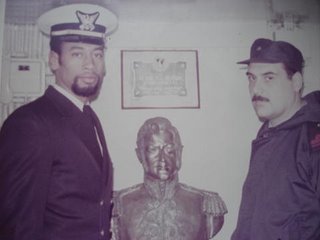U.S. Coast Guard to the rescue. Freeing the Argentine icebreaker, SanMartin, from the Antarctic pack ice.


He traveled to Antarctica during two patrols from July 1968 to August 1969, supporting the research operations of the National Science Foundation's Antarctic Research Project in and around McMurdo Station. During the 1969 patrol the CGC Glacier responded to an international distress call from the Argentine icebreaker General SanMartin, which was stuck solidly in the multi-year pack ice. the CGC Glacier was able to loosen the ice around the San Martin and allow her to break free. A Boarding Party was put aboard the San Martin. The Commanding Officer showed his appreciation by presenting a bottle of fine Argentine wine to the Marine Science Officer, Ltjg Steverson.



Labels: First Black Academy Graduates.


3 Comments:
Polar Star Heads to Antarctica to Help Russian Icebreaker
U.S. Coast Guard | January 19, 2006
SEATTLE – The Coast Guard Cutter Polar Star will depart its homeport of Seattle Friday for Antarctica as requested by the National Science Foundation to provide support to the Russian Icebreaker Krasin after the vessel recently experienced mechanical problems.
Polar Star, a 399-foot polar class icebreaker with a 134-person crew, will transit directly to Antarctica’s McMurdo Station arriving in approximately 30 days. Polar Star has been on 48-hour standby in Seattle since the beginning of the austral summer in case it was needed for Antarctic support.
Krasin has opened a channel through the ice into McMurdo Station and is currently grooming the channel. Although Krasin will most likely complete the mission, the National Science Foundation took the prudent step of calling in Polar Star due to the vulnerability of Krasin to further mechanical difficulty and the short window remaining in the Antarctic summer season.
For the past 50 years, Coast Guard icebreakers have deployed to Antarctica in support of Operation Deep Freeze, where ships have broken through as much as 84 nautical miles of ice to produce a navigable shipping channel into McMurdo Station. This vital shipping channel allows supply ships to deliver more than six million gallons of fuel and four thousand metric tons of cargo, enabling McMurdo Station and South Pole Station to remain manned and operational throughout the harsh winter months.
Polar Star, which was specifically designed for solo icebreaking in remote Polar Regions, turned 30 years old Jan. 17. The red cutter has a reinforced hull made of 1.5 inches of steel that covers a specially contoured icebreaking bow. The cutter can call on 75,000 shaft horsepower enabling it to break up to 21 feet of ice.
This will be the 51st Antarctic mission by a U.S. icebreaker. The first Operation Deep Freeze was carried out in 1955, the year that McMurdo Station was commissioned. Polar Star has deployed 15 times in support of Operation Deep Freeze, and 14 times for Arctic missions.
Polar Star Reaches Antarctica
U.S. Coast Guard | February 15, 2006
MCMURDO STATION, Antartica - The Coast Guard Cutter Polar Star arrived in McMurdo Station, Antarctica Monday, after a non-stop 8,200 nautical mile transit from its homeport of Seattle.
Polar Star, a 399-foot polar class icebreaker with a 130-person crew, provided a relief channel and brief escort of U.S. Naval Ship Lawrence H. Gianella before mooring in McMurdo.
While on deployment, Polar Star will conduct icebreaking operations in McMurdo Sound and continue grooming a shipping channel previously opened by the Russian icebreaker Krasin. The channel ensures that vital cargo ships can deliver supplies to McMurdo Station, Antarctica's largest scientific and support community. Polar Star also acts as a floating research platform for scientists that travel onboard.
For the past 50 years, Coast Guard icebreakers have deployed to Antarctica in support of Operation Deep Freeze, where ships have broken through as much as 84 nautical miles of ice to produce a navigable shipping channel into McMurdo Station. This vital shipping channel allows supply ships to deliver more than six million gallons of fuel and four thousand metric tons of cargo, enabling McMurdo Station and South Pole Station to remain manned and operational throughout the harsh winter months.
Polar Star, which was specifically designed for solo icebreaking in remote Polar Regions, turned 30 years old Jan. 17. The cutter's red reinforced hull is made of 1.75 inches of steel that covers a specially contoured icebreaking bow. The cutter can call on 75,000 shaft horsepower enabling it to break up to 21 feet of ice. Polar Star has deployed 15 times in support of Operation Deep Freeze.
Icebreaker Comes Home
U.S. Coast Guard | March 29, 2006
Seattle, WA. - The Coast Guard Cutter Polar Star will return to Seattle at 4:30 p.m. today after a whirlwind two-month Antarctic deployment in support of the scientific community at McMurdo Station.
The National Science Foundation contracted with the Russian icebreaker Krasin to break a re-supply channel into the science station this year, keeping the Polar Star on standby in Seattle in case it was needed. When the Krasin experienced mechanical problems, the 399-foot Polar Star was given 48 hours advance notice to get underway Jan. 20 with its 130-person crew.
The Polar Star traveled 8,200 nautical miles non-stop arriving in Antarctica Feb. 13 to begin grooming the channel previously opened by the Krasin. This critical channel makes it possible for ships to deliver supplies to McMurdo Station, Antarctica's largest scientific and support community. The Polar Star also groomed a runway near McMurdo Station to allow cargo planes to fly into the outpost.
For the past 50 years, Coast Guard icebreakers have deployed to Antarctica in support of Operation Deep Freeze, where ships have broken through as much as 84 nautical miles of ice to produce a navigable shipping channel into McMurdo Station. Polar Star, which turned 30 years old Jan. 17, was specifically designed for solo icebreaking in remote Polar Regions.
As economic interest in the Polar Regions continues to grow, it will become increasingly important for the U.S. to conduct national security and search and rescue operations in this remote area. The overarching purpose of the Coast Guard polar icebreaking program is to not only provide support to the scientific community, but also to project capability, power and influence, giving the U.S. a sovereign presence in this unique area of the world.
The Coast Guard is currently working with the National Academy of Sciences on an assessment of national polar icebreaking needs which should be completed in September. Funding authority for the nation's polar icebreaking program rests with the National Science Foundation.
Post a Comment
<< Home